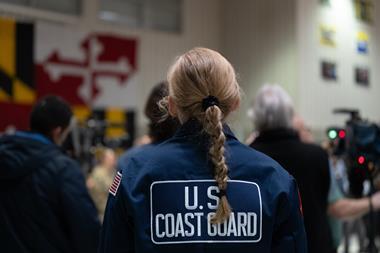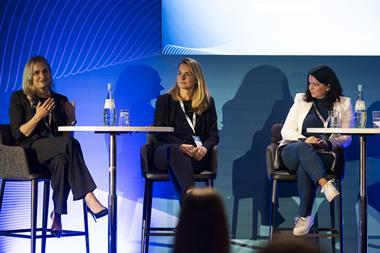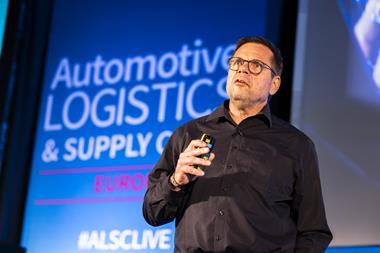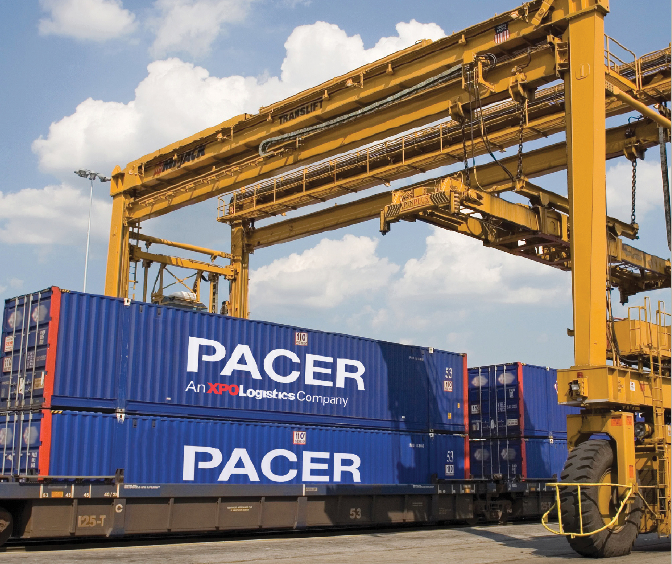 *This article is part of a special focus on Mexico. For other features related to the automotive supply chain in Mexico click here; for more on finished vehicle logistics in Mexico click here.
*This article is part of a special focus on Mexico. For other features related to the automotive supply chain in Mexico click here; for more on finished vehicle logistics in Mexico click here.
In the second part of this special Mexico report, we explore how huge amounts of automotive material crossing the border everyday, and OEMs and providers are increasingly interested in intermodal opportunities
Mexico’s automotive supply chain is strong across regional, global and domestic trade. For many companies, however, NAFTA is the backbone, both for serving the larger markets to the north and in supporting manufacturing with advanced supplies from across borders. Although the US has a $54 billion overall trade deficit with Mexico and sends only one car to Mexico for roughly every 11 that it imports, automotive components have a somewhat better balance. According to the US International Trade Commission, Mexico exported $36.2 billion worth of automotive parts to the US in 2013, and imported $21.1 billion.
But those figures do not quite reveal the complexity of the NAFTA supply chain. Carmakers like GM, Fiat Chrysler, Nissan and Ford move considerable material back and forth over the border. Delphi has 50 plants in Mexico that send many parts to the US, but it also imports a large amount of material and technology for Mexican production from the US. One 2011 study from the Woodrow Wilson International Center suggests that across the automotive, electronics, appliance and machinery industries, 40% of the content of Mexican imports to the US is actually of US origin (compared to only 4% American content for China imports).
Such complex supply chain links reflect the strong integration of Mexico’s automotive industry with the US and Canada. The physical infrastructure is obvious, but should not be taken for granted. Ferromex’s Alberto Sanchez believes that services along the country’s rail operators – which include Ferromex, its Ferrosur affiliate and KCSM – have been helped by shared equipment, standards and links with US and Canadian counterparts. The contrast with the various gauge and other inconsistencies for rail across Europe highlights what an advantage this is.
Central management
Perhaps equally important is the integration of management and systems that control material moving north and south. The degree of centralisation varies, but is strongest among American carmakers, which run much of their network engineering, purchasing and packaging development from Detroit, with regional teams responsible for operations to and from border points. For example, GM’s Elliot Swiss has full responsibility for parts logistics to and from Mexico.
Such structures allow shared supplies and logistics providers on both sides of the border. Fiat Chrysler’s Mercedes Figueroa points to common rail and intermodal contracts, as well as the company’s relationship with Ryder, which handles routing and network optimisation for the company’s North American and international flows. GM integrates services between two providers, according to Elliot Swiss. Ryder manages US and Canada-bound material, including what originates in Mexico, while Penske manages all material moving to Mexican plants from origin, including in the US and Canada.
Figueroa says central IT systems for production control and transport management are essential tools for managing North America as one network. “Chrysler has central tracking all the way from ASNs [automatic shipping notices] when suppliers ship the parts to the final destination, including electronic proof of service for payments to the supplier of parts as well as to logistics providers,” she says.
For GM, Ryder and Penske track the material. “We have also recently started implementing a tracking system for our returnable containers and racks across the border,” says Swiss. “It is our LLPs who are doing that.”

Nissan has particularly strong logistics organisations in both the US and Mexico. Daniel Saenzpardo, who heads logistics operations and management for Nissan in Mexico, says that the two sides collaborate mainly on the import and export of parts and vehicles between the US and Mexico, as well as for service parts distribution. Unlike Chrysler, systems for transport visibility, inventory and payments are not integrated.
Other transplant OEMs with historically separate logistics management for US, Canadian and Mexico operations have been realigning themselves. The Volkswagen Group, whose Silao engine plant feeds the US and Puebla, is working on closer connections for inbound and outbound. Mercedes-Benz has moved towards a NAFTA-orientated logistics setup for distribution across its passenger and commercial vehicle brands on the continent. American Honda, based in California, is now taking at least a ‘dotted line’ leadership for Mexico operations, including implementing standard yard management processes and systems.
Such close-knit management is critical for managing the huge amount of automotive material that moves both ways across the border. According to Swiss, GM moves around 2,500 conveyances every week between Mexico and the US. “It might be slightly more moving northbound because we have more plants in the US and Canada than in Mexico, but otherwise it is split roughly 50/50,” he says.
While the physical flows are fairly even, GM’s Mexican plants have a higher reliance on material originating from the north compared to what the US and Canada import from Mexico. Measured in cubic feet, Swiss estimates that the amount of material from Mexico consumed in GM’s US and Canadian plants is about 3% of total freight, while by the same measure, the company’s Mexican production consumes 17% of freight from the US and Canada.
As with GM, Fiat Chrysler’s Mexican production has a higher proportion of NAFTA freight than US and Canadian plants have from Mexico. Measured by transport loads, around 32% of Mexican-consumed cargo originates north of the border, according to Figueroa. That translates to about 51,000 annual loads by truck, rail or intermodal moving over the border to Mexico. Chrysler’s US and Canadian plants, on the other hand, consume about 5% of their material from Mexico, which is about 27,000 truck, rail or intermodal loads moving northbound to the US and Canada.
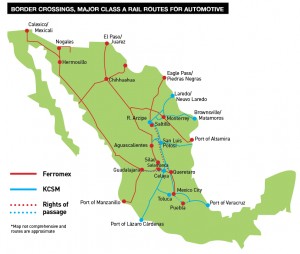
According to executives, cross-border trading is now relatively speedy and efficient, including by road. Figueroa and Swiss both credit improved customs processes, including pre-validation and electronic documentation. They also point to peak-time delays, however. Swiss is also concerned that the Mexican customs authorities have more restricted working hours compared to the US/Canadian border, which is open 24/7. “Things could get worse if Mexican customs continues to limit working hours,” he says.
Despite the relative efficiency at the border, streamlining the process is a top priority. “There are a number of handoffs between US carriers, dray carriers and Mexican carriers, and we are trying to make this more efficient,” Swiss says.
Julie Luna at XPO Logistics says a big opportunity to improve border crossing would be for the government to include tier supplier parts in the ‘Automotive Decree’. Currently, only carmakers can clear customs for production parts at their facilities. “Tier parts, or those moving to Mexico for additional assembly, do not enjoy these advantages – consequently, the border crossing process for these parts requires more time in transit.”
Luna adds that further integration and co-ordination between the US and Mexican governments will be needed to improve the flow of these shipments.
Rail advantages
Most agree that customs and crossings are generally smoother by rail and intermodal than by truck, which, as Swiss indicates, requires dray carriers to swap equipment. Luna points out that security is less of an issue as well, since the trains run at a higher speed and double-stack containers make theft more difficult. Ferromex’s Sanchez adds that the railways have worked with the Mexican government to improve interchange windows and increase operational hours. “There is a lot that can be done but huge advances have been made,” he says.
Executives are less concerned about the capacity to move material intermodally across the border than they are about finished vehicles. “The rail services [for parts] across the border work well, without many delays and with good security controls,” says Chris Styles. “The infrastructure and services in place are still pretty adequate, even for the expected growth.”
Railways as well as intermodal integrators like XPO are planning investments. This year, for example, the 3PL plans to add container chassis and capacity to support Mexican volume. It will also increase its partnerships with dray carriers to increase truck capacity. At the same time, the company has seen substantial increases in expedited shipments between the US and Mexico, partly driven by weather, says Luna.
 “Tier parts, or those moving to Mexico for additional assembly, do not enjoy [Automotive Decree] advantages – consequently, the border crossing process for these parts requires more time in transit.”
“Tier parts, or those moving to Mexico for additional assembly, do not enjoy [Automotive Decree] advantages – consequently, the border crossing process for these parts requires more time in transit.”- Julie Luna, XPO Logistics
Sanchez says Ferromex’s board has recently approved a $2.5 billion five year capital investment plan – 25% of its revenue –which will be used for network capacity, locomotives and wagons. “We are improving our consistency and transit times. We just launched two new intermodal services from Monterrey and Silao to Chicago, LA and other destinations.”
GM moves around half of its conveyances between the US and Mexico by rail or intermodal. A large amount of the intermodal volume is consolidated in Detroit, Chicago and Nashville before moving south; Mexican freight is consolidated near GM’s plant at Ramos Arizpe (close to Saltillo). There are further consolidation points for truck movement at the Texas-Mexico border at El Paso and Laredo. In total, Swiss says around 95% of GM’s US-Mexico cross-border freight moves via Laredo-Nuevo Laredo.
He adds that the carmaker is considering further consolidation points in Mexico as well as studying its long-haul truck movements from the US to Mexico for opportunities to convert to rail or intermodal. “For example, we are looking at how to move freight from the southeast of the US from road onto rail or intermodal,” he says.
Fiat Chrysler, meanwhile, already moves more of its southbound loads by rail or intermodal than it does by truck (see table below). According to Figueroa, the company shifts about 11,000 truckloads each year from the US and Canada to Mexico, compared to 30,000 intermodal loads and 10,000 loads by rail. Truck has a larger share for northbound freight from Mexico, with 14,000 truckloads, 7,000 intermodal and 6,000 pure rail loads. Figueroa adds that the carmaker has several consolidation centres in the US to help manage these flows across the border. “Through the years the central logistics organisation has worked hard to make the shift to intermodal and rail wherever possible,” she says.
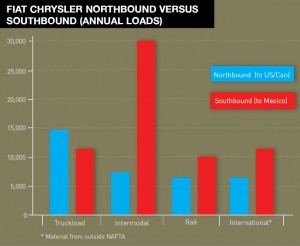
Fiat Chrysler moves all of its intermodal freight through Nuevo Laredo, which is an interchange between Union Pacific and KSCM; rail freight moves through the border at Eagle Pass-Piedras Negras (UP and Ferromex) to Saltillo plants and through Nuevo Laredo to Toluca.
Around 90% of Chrysler’s truck freight crosses through Nuevo Laredo, with 9% through Piedras Negras and the rest through El Paso-Juarez. Saenzpardo says that Nissan moves all of its truckloads through Laredo, where it has also seen some congestion.
Automotive container volume has historically been heavier southbound to Mexico for XPO Logistics, “but with the increase in parts production in Mexico, [flows] have become much more balanced,” says Luna. “The near-shoring trend to Mexico is contributing to a favourable environment for our services.”
XPO’s intermodal and cross-border services closely mirror the routes prevalent for GM and Chrysler. Intermodal flows move predominantly through Laredo and El Paso, although Luna says Eagle Pass is a growing interchange point. “The trade lane is typically from San Luis Potosi and Monterrey/Saltillo to Chicago and Detroit, and then back,” she says.
 "We have also recently started implementing a tracking system for our returnable containers and racks across the border. It is our LLPs who are doing that"
"We have also recently started implementing a tracking system for our returnable containers and racks across the border. It is our LLPs who are doing that"- Elliot Swiss, General Motors
Not everyone is satisfied that rail and intermodal services always work best, however, particularly for just-in-time logistics. Last year, Volkswagen executives told this magazine that the delivery time for engine exports by rail from Silao to the US were double those of truck. They also saw limited rail options between the US and the upcoming Audi plant. The company has, however, recently started using an intermodal service from the US Midwest to Mexico.
Nissan is also more limited in its rail and intermodal use, with one service moving northbound from Toluca and one for import to Aguascalientes. “They are working well, but we have to analyse a number of factors before taking a decision,” Garcia says. “We prefer to operate JIT and keep low inventory. Currently trucks are the most flexible option for us.”
While OEMs will continue to weigh up the balance between trucking flexibility and rail efficiency, some of the new production in Mexico looks set to increase intermodal links to the US as well. Honda’s Celaya plant has been built with intermodal handling facilities; sources say the company will consolidate the knockdown kit parts it already moves by rail from the US for its plant in Guadalajara with those for the new plant, and send them to Mexico using intermodal. If other OEMs enter Mexico with existing supply chains to the US southeast, such as Mercedes, BMW, Hyundai and Kia, rail links to these region may well grow further.



















